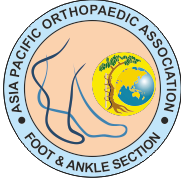Virtual Fellowship 2025
General Management
Soft tissues
Table of contents
1. General Management of Soft Tissue Injuries [edit]
1.1. 1. Acute Phase (First 24–72 Hours)
1.2. 2. Subacute and Chronic/Rehabilitation Phase
2. Pitfalls in Diagnosis [edit]
2.1. 1. Missing an Associated Fracture
2.2. 2. Mislabeling Serious Ligament/Joint Injuries as a Simple Sprain
The management of soft tissue injuries of the foot and ankle generally follows a progressive, phased approach, moving from acute care and protection to restoration of function through rehabilitation. However, a major challenge lies in the accurate diagnosis, as several serious injuries can initially present similarly to simple sprains, leading to potential long-term complications if missed.1
General Management of Soft Tissue Injuries [edit]
The initial management of acute soft tissue injuries (like sprains, strains, and contusions) has evolved slightly but still centers on controlling pain and swelling and initiating early, appropriate loading.
1. Acute Phase (First 24–72 Hours)
Management in the acute phase is focused on Protection and Rest to prevent further injury and manage symptoms. The well-known R.I.C.E. protocol has been updated to P.O.L.I.C.E. (Protection, Optimal Loading, Ice, Compression, Elevation) or even P.E.A.C.E. (Protection, Elevation, Avoid Anti-inflammatories, Compression, Education).
| Component | Action | Purpose |
| Protection | Restrict movement/activity; may use crutches, brace, or boot. | Prevents further damage to injured tissue. |
| Optimal Loading (or Relative Rest) | Gradually introduce gentle movement and weight-bearing as tolerated. | Stimulates tissue healing and prevents stiffness/weakness. |
| Ice | Apply cold packs for 10–20 minutes every 2–3 hours. | Reduces pain, swelling, and metabolic demand. |
| Compression | Use an elastic bandage or wrap (not too tight). | Helps control swelling and provides support. |
| Elevation | Keep the foot/ankle raised above the level of the heart. | Reduces swelling by promoting fluid drainage. |
| Avoid Anti-inflammatories | In the very acute phase, some protocols suggest avoiding NSAIDs (like ibuprofen) to not inhibit the body's natural initial inflammatory response, which is part of healing. Acetaminophen can be used for pain relief. | Allows natural healing cascade. |
2. Subacute and Chronic/Rehabilitation Phase
Following the initial period, the focus shifts to restoring full function. This phase aligns with the L.O.V.E.protocol (Load, Optimism, Vascularisation, Exercise) and physical therapy.
Load and Exercise (Rehabilitation): This involves a structured, progressive program to restore range of motion (ROM), strength, and proprioception (balance and joint position sense).
ROM exercises start early to prevent stiffness.
Strengthening exercises target muscles that support the foot and ankle, such as the peroneal tendons and calf muscles.
Proprioception training (e.g., single-leg stance, wobble board) is critical, especially for ankle sprains, to prevent chronic instability and re-injury.
Gradual Return to Activity: Activities are slowly progressed from walking to running, cutting, and sport-specific drills, often with the temporary use of tape or bracing for stability.
Optimism & Education: Patient education about the injury, expected recovery timeline, and the importance of active participation in rehabilitation is vital for a positive outcome.
Pitfalls in Diagnosis [edit]
A common and significant pitfall in the management of foot and ankle soft tissue injuries is the under-diagnosis or misdiagnosis of more severe injuries that are initially masked by symptoms similar to a common ankle sprain (lateral ligament injury).
1. Missing an Associated Fracture
The immediate pain and swelling of a soft tissue injury can often obscure an underlying bone injury.
Ottawa Ankle Rules (OAR): Failure to use or correctly apply the OAR can lead to missed fractures (e.g., distal fibula, base of the 5th metatarsal, or navicular bone). Conversely, over-reliance on the rules without considering patient specifics can lead to unnecessary X-rays.
Occult Fractures: Stress fractures (e.g., navicular stress fracture) may not be visible on initial X-rays and require a high index of suspicion based on history (overuse, new activity) and persistence of localized pain.
2. Mislabeling Serious Ligament/Joint Injuries as a Simple Sprain
Several severe injuries mimic a common lateral ankle sprain but require specific, often more aggressive, treatment.
High Ankle Sprain (Syndesmotic Injury): Injury to the ligaments connecting the tibia and fibula (syndesmosis). It often results in a less dramatic initial presentation than a severe lateral sprain but causes more prolonged disability and pain. It's often missed because the standard ankle X-rays may appear normal or the tenderness is above the common sprain site.
Lisfranc Injury: A fracture or ligamentous injury involving the midfoot (tarsometatarsal joints). If missed, it leads to collapse of the arch, chronic pain, and arthritis. It can be mistaken for a severe midfoot sprain, and subtle findings on X-ray require careful attention.
Tendon Ruptures: Complete tears of major tendons like the Achilles tendon or the Peroneal tendonscan be missed. For instance, in an Achilles rupture, the patient may still be able to slightly plantarflex the foot due to other intact muscles, leading to an underestimation of the severity.
Talus Osteochondral Lesions (OCL): Damage to the cartilage and underlying bone of the talus (ankle bone), which can cause persistent pain and "catching" sensation after an ankle sprain. Standard treatment for a simple sprain won't resolve this.
3. Anatomical and Imaging Pitfalls
Accessory Ossicles: Normal anatomical variants, like the Os Trigonum or accessory navicular bone, can be mistaken for fractures on X-ray, or conversely, a symptomatic injury to an accessory bone can be dismissed as a simple sprain.
Chronic Instability: Initial inadequate diagnosis or rehabilitation of a severe ligament tear (Grade III sprain) can lead to chronic ankle instability, characterized by recurrent sprains, pain, and a feeling of the ankle "giving way." This late complication stems from a failure to fully restore ligamentous stability, strength, and proprioception in the initial treatment phase.

